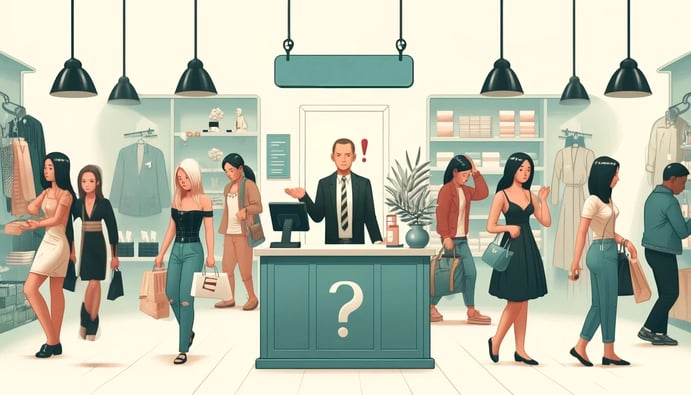How Retailers' Sales Tactics Ruin Impulse Buys and Considered Purchases

Subscribe to our newsletter
Updated October 3, 2024
I walked into a store in California last year, and what seemed like thousands of mason jar candles were stacked on a glass fixture from the '80s.
It was right next to the register.
I could see the logic of putting the display there. Candles are impulse items. We probably don't have to talk much about them. They could be grab-and-go items that increase sales.
The flaw in this thinking was the price point. These were $24.95.
That is not an impulse item.
Even though it is a small product, the price point made it a considered purchase and demonstrated what I want to draw a distinction for you about today in this post.
A considered purchase makes the customer stop and ask themself thoughtful questions:
- Is this a good value?
- How does it work?
- Will this last?
Flooring, automobiles, window fashions, and furniture are obvious examples of considered purchases. These are all large purchases that people have to think about before going shopping and incorporate new information they will receive in the store before buying.
So, what made these candles a considered purchase?
Right off a casual glance, the merchandising said commodity. Once you saw the price tag, you had questions. What is the scent? What are they made of? What am I getting for $25? What are the differences between these items?
A customer who has questions doesn't buy…they move on. This is why there were so many candles left sitting on the shelf.
Now, if those candles had a sign that said, "$6.95—Perfect for that brief blackout after a storm. Get several for peace of mind," the customer would know what they were getting and the use for the product and could envision the benefits of the purchase. They wouldn't have to think about it.
The purchase becomes a no-brainer, and it is easy for the customer, who hadn't even considered candles, to grab the impulse buy just in case.
Let's say you decide you want to be in the candle business.
Well, then your merchandising has to reflect that premium pricing of $24.95. You have to ensure the buyer knows what scents are available. You must merchandise so it doesn't look like a sea of products that haven't sold. You could have one lit so people are drawn to the scent (but that can open another challenge).
More importantly, you want to ensure you don’t take your passion for candles and overload someone with details.
How to Train Your Staff to Address Customers' Key Concerns and Questions
Your salespeople must balance providing necessary information for considered purchases and avoiding information overload that might overwhelm or confuse the customer when it is more of an impulse buy.
Let's say you give your employees all the product knowledge you can about these candles. They are made from soy sourced from non-GMO beans and infused with essential oils. The glass is made from recycled materials, and the packaging is entirely biodegradable. Customers can return the jar when the candles are spent and get a discount on a new one.
So now you have an employee who goes over to someone looking at the candles and shares some of these facts because you made candles at the top of that employee's mind. They think sharing is caring.
However, the right approach to information is critical. Here’s the thing to train: notice when something is an impulse.
A guy who won big in Vegas can walk into a Rolex dealer and say, “Give me a gold men’s watch with diamonds.”
At that moment, a great salesperson realizes they have precious time to ramp up their energy. They grab three best-selling and highest-priced watches, including the rare $40k Sky Dweller model, and invite him to the desk.
The customer then asks consideration questions, such as, “I don’t like that many diamonds; do you have something plainer? Do you have something bigger?” That way, the interest comes to you, and you’re not fishing for the specifics the customer cares about.
The salesperson too deep in the weeds might dampen his enthusiasm by asking a million qualifying questions, such as, “What size? White gold or stainless? Diamonds or no diamonds? Is it a gift?”
Your most important point in an impulse sale is getting it in their hands. If it’s footwear, sell it on their foot. If it's apparel, sell it in the fitting room when they are half-dressed. And if it's a watch, get it on their wrist.
Many employees sell the considered purchase as if it were an impulse item.
They say, "It's on sale for 40% off” or “If you have any questions, let me know.”
You get the idea. A considered purchase requires more time from both the selling and customer sides. It starts with active listening so salespeople understand and respond to a customer's needs and preferences when making a considered purchase.
Active listening techniques for salespeople include:
- Paraphrasing: Restate the customer's key points in your own words to ensure understanding.
- Asking open-ended questions: Encourage customers to share their needs and preferences more.
- Empathizing: Acknowledge the customer's feelings and concerns to build trust.
- Avoiding interruptions: Allow the customer to finish their thoughts before responding.
You need active listening to understand why that customer is shopping with you today. What is going on in their lives to make them come to your store and give you a chance to show and sell them something?
Where else have they been? What else have they tried? What would the best outcome be if they purchased something today?
The thoughtful purchase requires more advanced training to engage the shopper, understand their aspirations, and respect their days or weeks of thinking, researching, and planning. Think jewelry, appliances, vehicles, and electronics.
Think of an impulse buy as something we do on a whim, on a feeling, without thinking. That’s the key. The considered purchase requires a different mindset; the features are not apparent, and the benefits are even less.
How can retailers create a customer service experience that supports and encourages customers through the process of making a considered purchase?
Making a thoughtful purchase typically occurs when shoppers interact with knowledgeable and passionate associates about the product. For example, an associate at a golf store who plays the sport and has expertise in outfitting players with the best gear can connect with customers on a personal level, creating positive emotions that encourage customers to upgrade to higher-quality products.
That associate can relate to and give confidence to the shopper to make that purchase.
Considered purchases are more risky for consumers, as something they don't know could lead them to buy the wrong item. In the movie Tootsie, Jessica Lange’s character speaks about picking out the wallpaper. Her mom told her, “Just remember, the one you pick is going to cover the walls of your room for a long, long time.”
Considered purchases also hold more risk for retailers because if the salesperson doesn't understand how to proceed with a considered purchase, they will likely let it slip out of their hands.
Training programs for selling considered purchases should include:
- Building rapport to earn the right to sell the merchandise
- In-depth product knowledge: Understanding features, benefits, and unique selling points.
- Soft selling skills: Asking questions, active listening, and tailoring solutions to customers.
- Objection handling: Anticipating and addressing common concerns and hesitations.
- Storytelling: Using real-life examples and customer testimonials to illustrate product value.
- Upselling and cross-selling techniques: Identifying opportunities to enhance the customer's purchase.
Understanding the difference between impulse and considered purchases is key to boosting sales. Train your sales team to meet the unique needs of customers making considered purchases, creating a supportive environment that builds long-term relationships. Invest in training and smart visual merchandising to navigate both types of purchases, leading to higher sales and happier customers.
To help you with that, check out my online retail sales training program, SalesRX.com. 83% of users report a double-digit increase in sales within six months.



